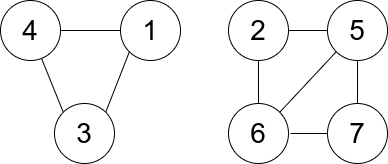You are given an undirected graph. You are given an integer n which is the number of nodes in the graph and an array edges, where each edges[i] = [ui, vi] indicates that there is an undirected edge between ui and vi.
A connected trio is a set of three nodes where there is an edge between every pair of them.
The degree of a connected trio is the number of edges where one endpoint is in the trio, and the other is not.
Return the minimum degree of a connected trio in the graph, or -1 if the graph has no connected trios.
Input: n = 6, edges = [[1,2],[1,3],[3,2],[4,1],[5,2],[3,6]] Output: 3 Explanation: There is exactly one trio, which is [1,2,3]. The edges that form its degree are bolded in the figure above.
Input: n = 7, edges = [[1,3],[4,1],[4,3],[2,5],[5,6],[6,7],[7,5],[2,6]] Output: 0 Explanation: There are exactly three trios: 1) [1,4,3] with degree 0. 2) [2,5,6] with degree 2. 3) [5,6,7] with degree 2.
2 <= n <= 400edges[i].length == 21 <= edges.length <= n * (n-1) / 21 <= ui, vi <= nui != vi- There are no repeated edges.
use std::collections::HashSet;
impl Solution {
pub fn min_trio_degree(n: i32, edges: Vec<Vec<i32>>) -> i32 {
let n = n as usize;
let mut edges_set = HashSet::new();
let mut count = vec![0; n + 1];
let mut ret = -1;
for i in 0..edges.len() {
let (u, v) = (
edges[i][0].min(edges[i][1]) as usize,
edges[i][0].max(edges[i][1]) as usize,
);
edges_set.insert((u, v));
count[u] += 1;
count[v] += 1;
}
for i in 1..=n {
for j in i + 1..=n {
if !edges_set.contains(&(i, j)) {
continue;
}
for k in j + 1..=n {
if !edges_set.contains(&(i, k)) || !edges_set.contains(&(j, k)) {
continue;
}
let degree = count[i] + count[j] + count[k] - 6;
if ret == -1 || degree < ret {
ret = degree;
}
}
}
}
ret
}
}
